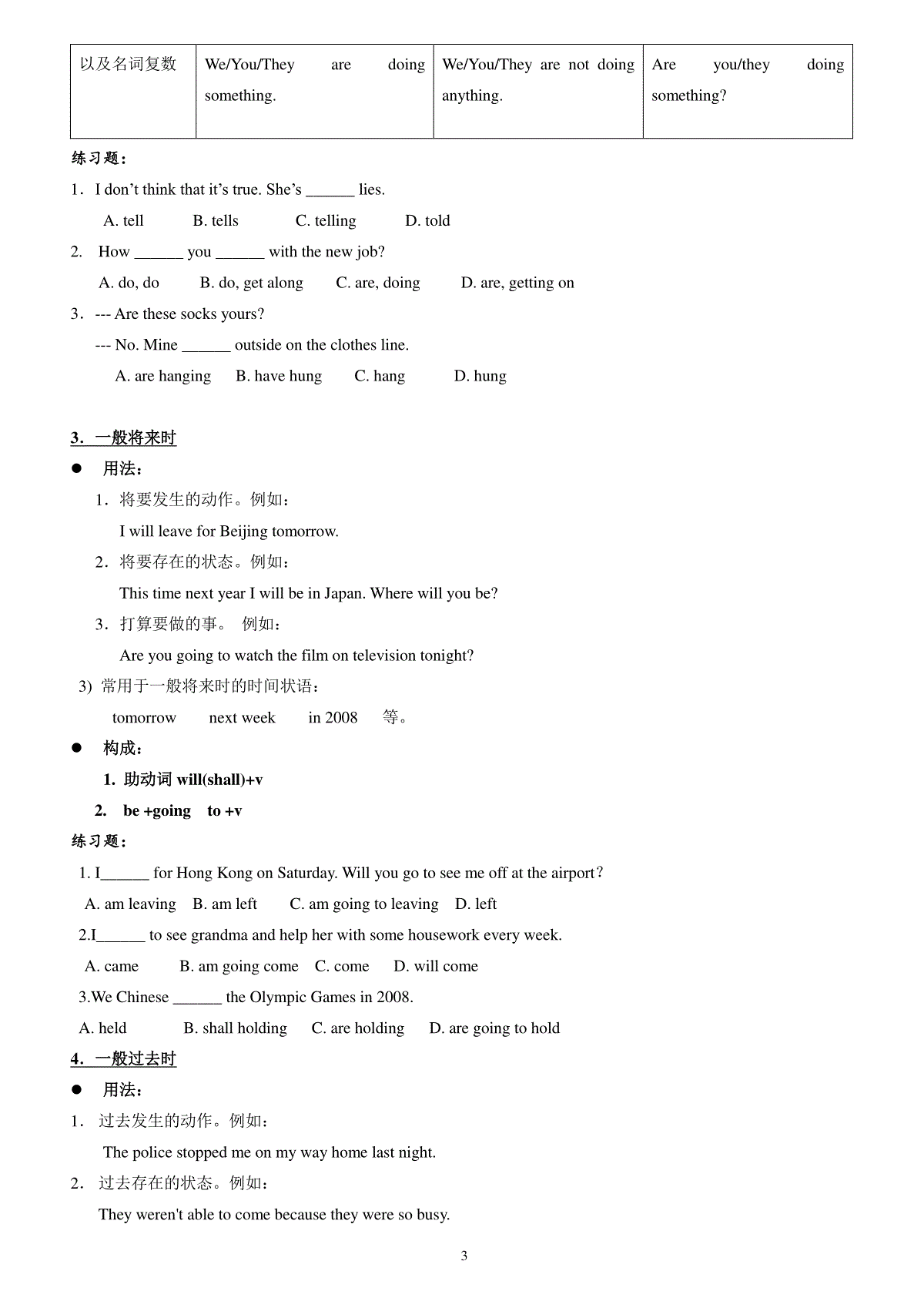当前位置:首页 > 中学教育 > 初中教育 > 初中英语时态总结(较简单)
1初中阶段,要求学生掌握动词6种时态的基本结构(一般现在时,一般过去时,现在进行时,过去进行时,现在完成时,和一般将来时态)及它们的主要用法和区别。了解过去将来、过去完成时态的基本用法,解题时注意找出关键词,正确判断出时态,按时态结构正确变化动词。注意句子时态的一致性,注意对特殊时态的处理。1、一般现在时:用法:1)现阶段经常性,习惯性的动作。例如:Igetupatsixeverymorning.Heplaystennisonceaweek.2)现在的状态。例如:Mymotherisateacher.SheteachesEnglishinaschool.3)客观真理。例如:Theearthgoesaroundthesun.4)常用于一般现在时态的时间状语:often,usually,sometimes,always,everyday,never,inthemorning等连用时。构成:主语是I,we,you,they和名词复数时作谓语的行为动词用原形。主语是he,she,it和名词单数时,动词第三人称单数的变法如下:一般情况+s以s,x,ch,sh,o结尾+es以辅音+y结尾变y为i+es主语为第三人称和名词单数时:肯定式:S+V/动词的第三人称单数否定式:S+don't/doesn't+V+其他疑问式:Do/Does+S+V+其他简略回答:(肯)Yes,S+do/does(否)No,S+do/doesnot注意:have的第三人称单数为has主语肯定式否定式疑问式第一、二人称和第三人称复数以及名词复数Iamastudent.We/You/Theyarestudents.He/Sheisastudent.I/We/You/They/likemusic.Manypeoplelikemusic.Iamnotastudent.We/You/Theyarenotstudents.He/Sheisnotastudent.I/We/You/They/don’tlikemusic.Manypeopledon’tlikemusic.Areyouastudent.Areyou/theystudents?Ishe/sheastudent?Doyou/theylikemusic?Domanypeoplelikemusic?当主语是第一、二人称和第三人称复数以及名词复数时:肯定式:S+be+···否定式:S+be+not+···疑问式:Am/Is/Are+S+···?简略回答:(肯)Yes,S+be.2(否)No,S+be.练习题:1.---MayIhelpyou,sir?---Yes,IboughttheTVthedaybeforeyesterday,butit______.A.didn’tworkB.doesn’tworkC.won’tworkD.can’twork2.______thebusuntilit______..A.Getoff,stopsB.Getoff,willstopC.Don’tgetoff,stopsD.Don’tgetoff,willstop3.The70-year-oldman______exercisesinthemorning.A.takesB.aretakingC.tookD.willtake2.现在进行时用法:1)说话时正在进行或发生的动作(动作是在说话时正在进行)。例如:Sheishavingabathnow.2)现阶段正在进行或发生的动作(但是动作并不是必须在说话时正在进行)。例如:Youareworkinghardtoday.KatewantstoworkinItaly,sosheislearningItalian.Thepopulationoftheworldisgrowingveryfast.3)频度副词always,forever等词连用时,表示某种强烈的感情。如:Heisalwaystryingoutnewideas.(表示欣赏,表扬)4)表示按计划即将发生的动作(仅限于go,come,arrive,leave,start,fly,begin,stay等动词)。如:Thepartyisbeginningat8:00o’clock..5)常用于现在进行时态的时间状语:now,look,listen等。构成:be+v-ingv-ing现在分词的构成:一般情况cook-cooking以不发音字母e结尾的单词。去e,加ingmake-making,taste-tasting以重读闭音节结尾的单词,末尾只有一个辅音字母时.run-running,stop-stopping,2)肯定句、否定句、疑问句形式:肯定句:S+be+V-ing否定句:S+be+not+V-ing一般疑问句:Is(Are)+S+V-ing?特殊疑问:wh_+be+S+V-ing?e.g.主语肯定式否定式疑问式第一、二人称和第三人称复数Iamdriving.He/She/Itisworking.Iamnotdriving.He/She/Itisnotworking.Areyoudriving?Ishe/she/itworking?3以及名词复数We/You/Theyaredoingsomething.We/You/Theyarenotdoinganything.Areyou/theydoingsomething?练习题:1.Idon’tthinkthatit’strue.She’s______lies.A.tellB.tellsC.tellingD.told2.How______you______withthenewjob?A.do,doB.do,getalongC.are,doingD.are,gettingon3.---Arethesesocksyours?---No.Mine______outsideontheclothesline.A.arehangingB.havehungC.hangD.hung3.一般将来时用法:1.将要发生的动作。例如:IwillleaveforBeijingtomorrow.2.将要存在的状态。例如:ThistimenextyearIwillbeinJapan.Wherewillyoube?3.打算要做的事。例如:Areyougoingtowatchthefilmontelevisiontonight?3)常用于一般将来时的时间状语:tomorrownextweekin2008等。构成:1.助动词will(shall)+v2.be+goingto+v练习题:1.I______forHongKongonSaturday.Willyougotoseemeoffattheairport?A.amleavingB.amleftC.amgoingtoleavingD.left2.I______toseegrandmaandhelpherwithsomehouseworkeveryweek.A.cameB.amgoingcomeC.comeD.willcome3.WeChinese______theOlympicGamesin2008.A.heldB.shallholdingC.areholdingD.aregoingtohold4.一般过去时用法:1.过去发生的动作。例如:Thepolicestoppedmeonmywayhomelastnight.2.过去存在的状态。例如:Theyweren'tabletocomebecausetheyweresobusy.43.常用于一般过去时的时间状语:yesterday,threemonthsago,lastyear,in1979,等。构成:S+V-ed用动词的过去式。作谓语的行为动词的词尾变化如下:一般情况+ed以e字母结尾的辅音+d以辅音字母+y结尾去y变i+ed重读闭音节结尾的单词,末尾只有一个辅音字母双写词尾字母+ed2)一般过去时态的肯定句、否定句和疑问句形式(以be和like为例):主语肯定式否定式疑问式第一、二人称和第三人称复数以及名词复数Iwasastudent.We/You/Theywerestudents.He/Shewasastudent.I/We/You/They/likedmusic.Manypeoplelikedmusic.Iwasnotastudent.We/You/Theywerenotstudents.He/Shewasnotastudent.I/We/You/They/didn’tlikemusic.Manypeopledidn’tlikemusic.Wereyouastudent.Wereyou/theystudents?Washe/sheastudent?Didyou/theylikemusic?Didmanypeoplelikemusic?练习题:1.r.Mottisout.Buthe______hereafewminutesago.A.wasB.isC.willbeD.wouldbe2.---Hi,Tom.---Hello,Fancy.I______youwerehere.A.don’tknowB.won’tthinkC.thinkD.didn’tknow3.HepromisedtotellmebyhimselfwhenI______.A.comeB.wouldcomeC.comeD.hadcome5、过去进行时概念:1)过去某一阶段或某一时刻正在进行的动作。例如:ThistimelastyearIwaslivinginBrazil.Whatwereyoudoingat10o'clocklastnight?2)常用于过去进行时的时间状语:atfouryesterdayafternoon,then,atthattime/moment等。构成:was/were+v-ing1)Daddypromisedmehe______meacomputer5A.wasboughtB.hadboughtCboughtD.wouldbuy2)Theysaidthey______dosomesportsifitwasfine.A.weregoingtoB.wentC.wouldgoingD.weregoing6、现在完成时概念:1)表示过去发生的动作对现在造成的影响或结果.常与already,just,ever,never,before等词连用.如:Shehasneverreadthisnovel.2)表示“过去的动作”一直延续到现在并有可能继续延续下去.常与for(后跟段时间)或since(后跟点时间)等连用.如:IhavebeenamemberofthePartyfor10years.IhavebeenamemberofthePartysince10yearsago.注:在有for和since引导时间状语的句子中不能用短暂性动词,应用与之相应的表示状态的词。如:Hehasdiedfor3years.(F)Hehasbeendeadfor3years.(T)注:①现在完成时不能和表示明确的过去时间连用。如:in1998,lastmorning等②have/hasbeento表示“去过”(去了又回来了)have/hasgoneto表示“去过”(去了没回来了)如:Wherehasshegone?(句中所指的人不在)Wherehasshebeen?(句中作指的人在)构成:have/has+v-ing2)现在完成时态的肯定句、否定句和疑问句形式(以be和see为例):肯定句:S+have(has)+V-ed否定句:S+have(has)+not(haven’t,hasn’t)+V-ed一般疑问句:Have(Has)+S+V-ed+?特殊疑问句:wh_+have(has)+S+V-ed+?主语肯定式否定式疑问式第一、二人称和第三人称复数以及名词复数I/We/You/Theyhavebeenherebefore.He/She





 三七文档所有资源均是用户自行上传分享,仅供网友学习交流,未经上传用户书面授权,请勿作他用。
三七文档所有资源均是用户自行上传分享,仅供网友学习交流,未经上传用户书面授权,请勿作他用。
本文标题:初中英语时态总结(较简单)
链接地址:https://www.777doc.com/doc-2662833 .html